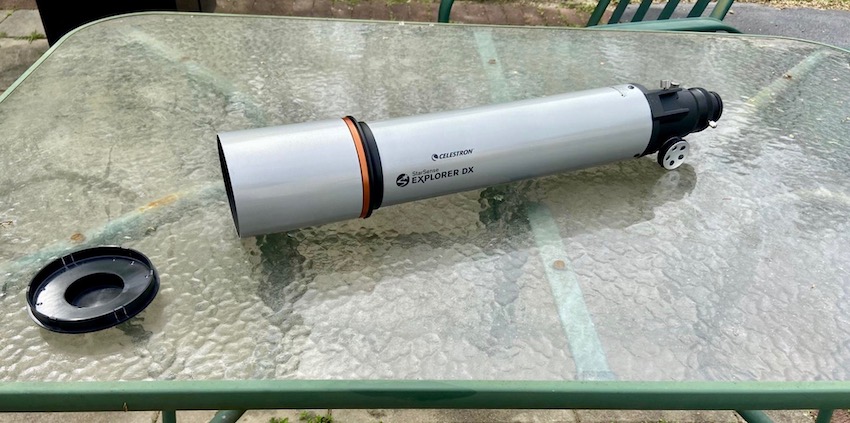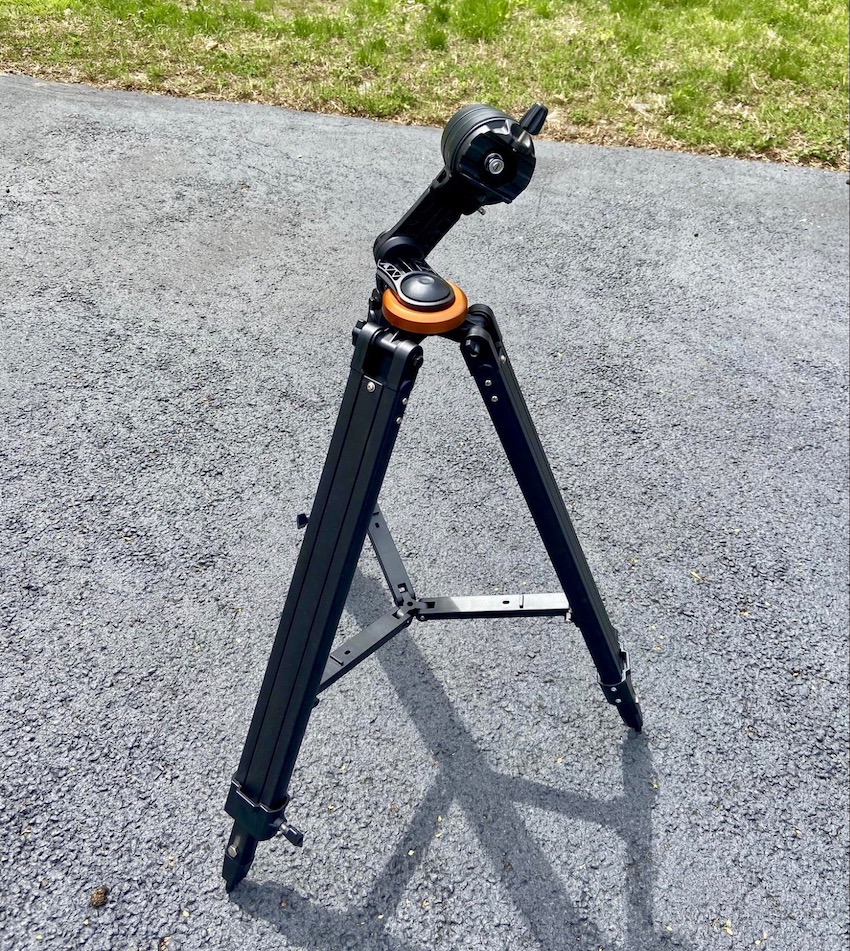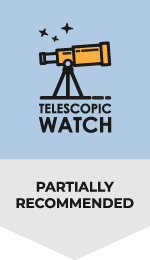The Refractor OTA and the Focuser

The DX 102’s optical tube is a 102mm f/6.5 refractor with a focal length of 650mm, the same as used on many other Celestron telescope/mount packages like the Omni 102 AZ and NexStar 102SLT. At this aperture and focal ratio, there is a fair amount of chromatic aberration, but sharp views of the Moon and planets are still possible.
The DX 102 has a 2” rack-and-pinion focuser, but it cannot actually balance on its mount with a 2” diagonal and eyepiece, so in practice, the scope is limited to 1.25” eyepieces and accessories only. Thankfully, even with 1.25” eyepieces, you can squeeze out a field of view of about 2.5 degrees with a 32mm Plossl or similar, so this should not be of huge concern to a beginner.
A Fair Alt-Azimuth Mount

The StarSense Explorer DX mount is nothing more than a repainted Omni XLT AZ or “AZ3” mount with a bracket for the StarSense Explorer device. This mount is a little on the small side for either optical tube, but it works just fine. It’s a simple, aluminum-legged alt-azimuth mount with slow-motion controls on both axes. The accessory tray is a nice, sturdy affair and an actual tray rather than the silly eyepiece rack supplied with many scopes. A pair of flexible slow-motion cables are included for making fine adjustments, though the backlash from them can be annoying when using high magnifications, and it’s not as intuitive as a simple Dobsonian mount, for instance.
The StarSense Explorer Technology & App
At its core, the StarSense Explorer actually uses a relatively old technology known as plate-solving. In essence, what it does is take a snapshot of the sky and use computer algorithms and star maps to figure out where it is pointing. Normally, this is done for astrophotography to avoid performing a time-consuming GoTo alignment and is only used to find one target.
In principle, the StarSense Explorer tech is basically a bracket to point your phone at a small mirror that has been aligned to the telescope mount, and then uses the phone’s onboard camera and processing power to plate-solve.
Thanks to your phone’s limited battery life and computing power, the StarSense Explorer technology obviously can’t take a new picture of the sky every time you move the telescope. It would kill your phone quite fast. Instead, it occasionally uses plate-solving technology when you first set up the telescope or move it across a significant portion of the sky, then tries its best to extrapolate finer movements using your phone’s relatively inaccurate gyroscope and accelerometer. In practice, this system is limited to an accuracy of a bit better 0.25 degrees, or half the width of a full moon. This is much less precise than a real GoTo system with tracking but much simpler, easier, and more reliable than a motorized telescope.
Many people have asked on astronomy forums and contacted Celestron themselves, asking why the bracket and code cannot be sold as a stand-alone item. Celestron’s main explanation is that many beginners would buy the bracket and attempt to fit it onto substandard telescopes (or simply do it improperly) and become frustrated. We previously complained about the lack of targets in the app’s database, but Celestron has updated the app and drastically expanded its number of objects, greatly increasing its overall utility.
The Eyepieces of the StarSense Explorer DX Series

The StarSense Explorer DX 102 includes two 1.25” eyepieces: a 25mm “Super” Konig providing 26x and a 10mm Konig providing 65x. These eyepieces have a lot of plastic in their build, but use glass optics and are fairly sharp, with more eye relief than a typical Plossl ocular (particularly beneficial with the 10mm). There are some issues with glare and ghosting, and they are slightly inferior in sharpness to a true Plossl design, but both eyepieces are comfortable to use and work well, though they are a bit below what you should be expecting in quality at this price point. The DX 102 includes a 1.25″ Amici prism star diagonal, which is mostly plastic and has some issues with glare and a diffraction spike on bright targets. This diagonal is definitely a weak link in the scope optically, and replacing it might be a good idea. However, it’s enough to get you started.
Should I buy a used StarSense Explorer DX 102AZ?
A used StarSense Explorer scope will likely be missing the code for the app and many of the scopes floating around have had their phone brackets yanked off as well for use on other instruments. So unless you can be sure it has those or the price is absurdly low, we’d recommend you pass.
Alternative Recommendations
There are some other manuals as well as computerized scopes in the DX 102 AZ’s price range that you might want to take a look at:
- The StellaLyra 8”/Zhumell Z8/Orion SkyLine 8 has nearly double the aperture, significantly better accessories, and a simpler mount than the StarSense Explorer DX 102 AZ. You can actually buy digital setting circles/encoders such as the Romer Optics EZ Push To that basically emulates the StarSense Explorer setup with your phone.
- The Sky-Watcher Virtuoso 150P has more aperture than the DX 102 AZ but without the chromatic aberration and in an extremely compact package, with full GoTo and tracking operated by your smartphone along with the ability to be aimed manually. The all-manual Heritage 150P is identical but lacks electronics.
- The Celestron Astro-Fi 130 have a bit more aperture than the DX 102 AZ and will automatically aim around the sky via commands from your smartphone, and track objects without any manual adjustment. The Astro-Fi requires a full GoTo alignment to use and is mounted atop a tripod, while the Virtuoso is a tabletop scope but can be used manually with or without the electronics being switched on.
Aftermarket Accessory Recommendations
As mentioned earlier, the StarSense Explorer DX 102 AZ is provided with a cheap Amici prism. This prism’s “erect image” is, of course, unnecessary for astronomical use, while the diagonal is both cheaply made and optically compromised, choking the light path of the telescope and reducing sharpness and contrast. A high-quality prism star diagonal, such as the Celestron 94115-A Prism Star Diagonal, effectively eliminates all of the issues caused by the Amici prism supplied with this scope and is fairly affordable too.
Once you’ve upgraded your diagonal to one designed specifically for astronomical use, there are several eyepieces worth considering for the StarSense Explorer DX 102 AZ to complement the supplied pair of oculars. A 32mm Plossl eyepiece offers the widest possible true field achievable in a 1.25″ format eyepiece, approximately 2.6 degrees across at 20x magnification with the StarSense Explorer DX 102 AZ. In addition, a 6mm goldline or redline eyepiece provides 108x magnification, perfect for planetary viewing or splitting double stars and about the maximum magnification that you’ll find yourself wanting to use regularly with this telescope. If desired, you could also acquire a 15mm redline/goldline for 43x to fit between the stock 20mm and 10mm eyepieces for medium magnification.
One other accessory you might want to pick up for the StarSense Explorer DX 102 AZ is a quality UHC/OIII nebula filter. It doesn’t “filter out” light pollution but rather increases contrast on nebulae, making them appear brighter against the background and bringing out subtle detail. This filter works great with the StarSense Explorer DX102AZ, which under dark skies with a filter will show you huge swaths of nebula regions like the North America or Veil Nebula, for instance. Even under a dark sky, the UHC brings out more contrast by darkening the sky background.
What can you see with Explorer DX 102AZ?
The StarSense Explorer DX-102 is limited to brighter objects by the nature of its small aperture. The Moon looks pretty good, while Mercury and Venus show nothing besides their phases. Mars’ dark spots can be seen, although barely, when the planet is close to Earth, while its polar ice caps are a little more obvious. Jupiter’s cloud belts and the Great Red Spot are relatively easy to see, and you can just make out the disks of its four moons when they transit the planet. Saturn’s rings and the Cassini Division within them look fabulous, while its dimmer moons and cloud belts are a bit harder to spot. Uranus and Neptune are barely more than star-like dots, with blue disks barely bigger than the resolving limit of the telescope itself.
Deep-sky objects are a little less exciting. Open star clusters look great and benefit from the 102AZ’s wide field of view, but globular star clusters are little more than fuzzy balls. Particularly under dark skies, bright nebulae like Orion and the Lagoon look great, but planetary nebulae such as the Cat’s Eye are really too small and dim to be interesting in the 102. Galaxies are almost certain to disappoint, as few will show detail under dark skies, and a beginner will struggle to see them all in light-polluted conditions.


